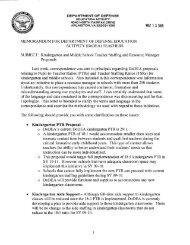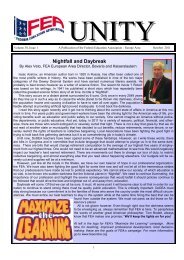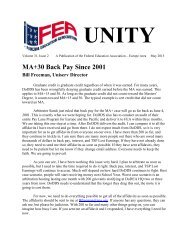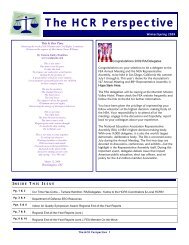FEA Guidance concerning the “10-Mile Rule” As the ... - FEA Online!
FEA Guidance concerning the “10-Mile Rule” As the ... - FEA Online!
FEA Guidance concerning the “10-Mile Rule” As the ... - FEA Online!
You also want an ePaper? Increase the reach of your titles
YUMPU automatically turns print PDFs into web optimized ePapers that Google loves.
<strong>FEA</strong> <strong>Guidance</strong> <strong>concerning</strong> <strong>the</strong> <strong>“10</strong>-<strong>Mile</strong> <strong>Rule”</strong><br />
<strong>As</strong> <strong>the</strong> result of several successful <strong>As</strong>sociation grievances and litigation, a DoDDS local<br />
hire in <strong>the</strong> <strong>As</strong>sociation’s bargaining unit may obtain housing and transportation benefits<br />
is he/she is reassigned or transferred outside of <strong>the</strong> “commuting area,” in addition to<br />
meeting certain o<strong>the</strong>r criteria.<br />
One of <strong>the</strong> above-mentioned <strong>As</strong>sociation victories specifically dealt with <strong>the</strong> issue of<br />
whe<strong>the</strong>r <strong>the</strong> <strong>“10</strong>-mile rule” should still be followed in our bargaining unit to determine<br />
whe<strong>the</strong>r a move was outside of <strong>the</strong> “commuting area.” The decision in <strong>the</strong> case heard by<br />
Arbitrator Jascourt was that <strong>the</strong> <strong>“10</strong>-mile rule” controls in <strong>the</strong> <strong>As</strong>sociation’s bargaining<br />
unit, and that subsequent changes to <strong>the</strong> JTR regulations on this matter were barred.<br />
The purpose of this update is only to provide some additional information regarding what<br />
constitutes a move outside of <strong>the</strong> “commuting area” in <strong>the</strong> <strong>As</strong>sociation’s bargaining unit<br />
following <strong>the</strong> Jascourt decision, as well as <strong>the</strong> general rules for local hires to obtain LQA<br />
when <strong>the</strong>y are moved.<br />
I. History of <strong>the</strong> <strong>“10</strong>-mile rule”<br />
One method for a local hire employee to become eligible for housing benefits (living<br />
quarters allowances, or LQA), is for <strong>the</strong> employee to be moved by management through a<br />
permanent change in station (PCS) move outside of <strong>the</strong> commuting area (defined in <strong>the</strong><br />
Joint Travel Regulations (JTR)). The JTR defines <strong>the</strong> criteria used in making <strong>the</strong><br />
determination whe<strong>the</strong>r <strong>the</strong> employee is eligible for a PCS.<br />
For a move involving a “short” distance, “old” JTR paragraph C4108 (<strong>the</strong> 10-mile rule)<br />
provided <strong>the</strong> criteria for making <strong>the</strong> determination whe<strong>the</strong>r a local hire employee was<br />
eligible for a PCS move. If <strong>the</strong> employee meets all of <strong>the</strong> requirements of “old” JTR<br />
paragraph C4108 and is determined eligible for a PCS, <strong>the</strong>n <strong>the</strong> employee would be<br />
entitled to LQA at <strong>the</strong>ir new residence. When “old” JTR paragraph C4108 was revised<br />
over <strong>the</strong> objection of <strong>the</strong> <strong>As</strong>sociation, <strong>the</strong> <strong>As</strong>sociation filed a grievance.<br />
Arbitrator Jascourt ruled in favor of <strong>the</strong> <strong>As</strong>sociation and ordered regulations in conflict<br />
with <strong>the</strong> negotiated agreement between DoDDS and <strong>FEA</strong> be negated. In particular, <strong>the</strong><br />
changes to “old” JTR paragraph C4108 that had increased <strong>the</strong> distance from 10 miles to<br />
50 miles were rescinded. Therefore, for employees in <strong>the</strong> <strong>As</strong>sociation’s bargaining unit,<br />
<strong>the</strong> <strong>“10</strong>-mile rule” in “old” JTR paragraph C4108 remains in effect.<br />
II. What is <strong>the</strong> <strong>“10</strong>-mile rule?”<br />
Generally speaking, <strong>the</strong> <strong>“10</strong>-mile rule” is a JTR regulation (“old” JTR paragraph C4108)<br />
that governs when a local hire employee who is moved a “short distance” by management<br />
may be eligible for a PCS, and subsequently LQA. When management determines that<br />
<strong>the</strong> local hire employee has met <strong>the</strong> JTR requirements for <strong>the</strong> <strong>“10</strong>-mile rule” listed in
“old” JTR paragraph C4108, <strong>the</strong> employee is deemed eligible for a PCS move and will<br />
become eligible for housing benefits (LQA) for <strong>the</strong>ir new residence.<br />
III. What are <strong>the</strong> requirements of <strong>the</strong> <strong>“10</strong>-mile rule?”<br />
<strong>As</strong> a result of <strong>the</strong> <strong>As</strong>sociation’s victory in <strong>the</strong> Jascourt arbitration, DoDDS must apply <strong>the</strong><br />
requirements of <strong>the</strong> “old” JTR paragraph C4108 (<strong>the</strong> 10-mile rule) (before this paragraph<br />
was subsequently revised and moved to a different chapter of <strong>the</strong> JTR) to local hire<br />
employees in <strong>the</strong> <strong>As</strong>sociation’s bargaining unit in determining whe<strong>the</strong>r <strong>the</strong>y are eligible<br />
for a short distance PCS.<br />
Please be aware that “old” JTR paragraph C4108 has a number of requirements,<br />
and <strong>the</strong> determination is NOT based solely on distance between <strong>the</strong> old and new<br />
duty stations.<br />
Generally speaking, <strong>the</strong> requirements of “old” JTR paragraph C4108 (<strong>the</strong> 10-mile rule)<br />
are that <strong>the</strong> move by <strong>the</strong> employee must be:<br />
• in <strong>the</strong> interest of <strong>the</strong> government;<br />
• to a new permanent duty station (PDS) which is at least 10 miles distant<br />
from <strong>the</strong> old PDS;<br />
• is not primarily for <strong>the</strong> convenience/benefit of <strong>the</strong> employee, or at his/her<br />
request;<br />
• relocation of <strong>the</strong> residence is incident to <strong>the</strong> transfer<br />
Previous Version of JTR Paragraph C4108<br />
However, <strong>the</strong> analysis does not end <strong>the</strong>re. The “old” JTR paragraph C4108 also had a<br />
clarifying paragraph explaining how <strong>the</strong>se requirements are to be applied. The clarifying<br />
paragraph states:<br />
“In determining if <strong>the</strong> relocation of residence is incident to <strong>the</strong> transfer, <strong>the</strong> travelapproving<br />
official should take into consideration such factors as commuting time<br />
and distance between <strong>the</strong> employee’s residence at <strong>the</strong> time of notification of <strong>the</strong><br />
transfer and his/her old and new duty station as well as <strong>the</strong> commuting time and<br />
distance between a proposed new residence and <strong>the</strong> new duty station. Ordinarily,<br />
a relocation of residence should not be considered as incident to a PCS unless <strong>the</strong><br />
one-way commuting distance from <strong>the</strong> old residence to <strong>the</strong> new duty station is at<br />
least 10 miles greater than from <strong>the</strong> old residence to <strong>the</strong> old duty station. Even<br />
<strong>the</strong>n, circumstances surrounding a particular case, for example, relative<br />
commuting time, may suggest that relocation of residence was not incident to <strong>the</strong><br />
transfer.”<br />
IV. How is <strong>the</strong> <strong>“10</strong>-mile rule”/“old” JTR paragraph C4108 applied by DoDDS?
The following is management’s position on <strong>the</strong> proper application of <strong>the</strong> <strong>“10</strong>-mile rule.”<br />
In order to avoid complications, you should follow <strong>the</strong> steps below. The process for<br />
determining whe<strong>the</strong>r <strong>the</strong> employee has met all of <strong>the</strong> requirements of “old” JTR<br />
paragraph C4108 has several elements. Management’s position is that <strong>the</strong> local hire<br />
employee must meet each one of <strong>the</strong> requirements, or DoDDS will determine that <strong>the</strong><br />
employee is not to be eligible for a PCS, and subsequently will not get LQA.<br />
A. The First Element<br />
The first determination that management must make is whe<strong>the</strong>r <strong>the</strong> move is “in <strong>the</strong><br />
interest of <strong>the</strong> government,” and not at <strong>the</strong> employee’s request/interest. In o<strong>the</strong>r words, if<br />
a local hire educator asks to be transferred (outside of <strong>the</strong> Washington DC Transfer<br />
Program or o<strong>the</strong>r management directed program), or arranges <strong>the</strong>ir own deal with<br />
administration to move from one school to ano<strong>the</strong>r, this is usually determined by DoDDS<br />
to not be in <strong>the</strong> interest of <strong>the</strong> government. If a local hire educator voluntarily applies for<br />
ano<strong>the</strong>r position (outside of <strong>the</strong> Transfer Program, or some o<strong>the</strong>r management directed<br />
program), <strong>the</strong>n DoDDS may decide that this move is in <strong>the</strong> educator’s own interest, and<br />
not in <strong>the</strong> interest of <strong>the</strong> government. Therefore, management’s position would be to<br />
decide that it is unlikely that such actions would meet this element, and <strong>the</strong> PCS request<br />
would probably be denied.<br />
However, being reassigned by management can involve a move under <strong>the</strong> Washington<br />
DC Transfer Program, a management-directed transfer, or when an educator is declared<br />
excess at a school. All of <strong>the</strong>se moves or reassignments are in <strong>the</strong> interest of <strong>the</strong><br />
government, and would meet this element’s requirements.<br />
B. The Second Element<br />
The second determination that management must make is whe<strong>the</strong>r <strong>the</strong> distance from <strong>the</strong><br />
local hire employee’s old permanent duty station (PDS) to <strong>the</strong> new PDS is at least 10<br />
miles. PLEASE NOTE that management’s position is that under <strong>the</strong> JTR regulations, <strong>the</strong><br />
10 miles in question are NOT determined by your map, <strong>the</strong> distance on your car’s<br />
odometer, or by a computer map program. Instead, it is determined by <strong>the</strong> DoD Table of<br />
Official Distances (DTOD). In o<strong>the</strong>r words, management will use <strong>the</strong> DTOD to<br />
determine <strong>the</strong> “official distance” between <strong>the</strong> duty stations. This element will only be<br />
met if <strong>the</strong> DTOD confirms that <strong>the</strong> official distance between your old and new duty<br />
stations is 10 miles or more.<br />
C. The Third Element<br />
The third determination by management is whe<strong>the</strong>r <strong>the</strong> PDS will increase <strong>the</strong> local hire<br />
employee’s commute by more than 10 miles. Management will first measure <strong>the</strong> distance<br />
from <strong>the</strong> employee’s existing residence to <strong>the</strong> old PDS. Then, <strong>the</strong>y will measure <strong>the</strong><br />
distance from <strong>the</strong> employee’s existing residence to <strong>the</strong> new PDS. Finally, management<br />
will compare <strong>the</strong> two commutes. If <strong>the</strong> new commute exceeds <strong>the</strong> old commute by 10
miles, management will probably determine that <strong>the</strong> employee is eligible for a PCS<br />
move.<br />
PLEASE NOTE that management interprets this element to mean that if <strong>the</strong> employee’s<br />
commute is actually shorter (from <strong>the</strong> residence to <strong>the</strong> new PDS as against <strong>the</strong> old PDS),<br />
<strong>the</strong>n <strong>the</strong> employee is not eligible for a PCS. In o<strong>the</strong>r words, if <strong>the</strong> commute from your<br />
residence to <strong>the</strong> old PDS was 15 miles, but <strong>the</strong> commute from your residence to <strong>the</strong> new<br />
PDS is 13 miles, management will determine that as <strong>the</strong> commute is actually shorter.<br />
Since it does not increase <strong>the</strong> commute by 10 miles or more, management’s position is<br />
that you do not meet <strong>the</strong> second element and will deny your request for PCS orders.<br />
D. The Fourth Element<br />
In addition to <strong>the</strong> above-listed elements, management’s position is that <strong>the</strong> local hire<br />
employee must also move <strong>the</strong>ir residence. In o<strong>the</strong>r words, <strong>the</strong> distances involved are not<br />
<strong>the</strong> only factors. If you do not move your residence “incident to <strong>the</strong> transfer,” <strong>the</strong>n<br />
management’s position is that you will not have met <strong>the</strong> final element of <strong>the</strong> regulation.<br />
However, we would strongly advise, to avoid complications, that you ask management<br />
for a pre-determination of your eligibility for LQA BEFORE contemplating a move of<br />
your residence. Please note that if you do not meet management’s above-listed criteria,<br />
management’s position is that it will not matter if you move your residence or not. If<br />
management determines that any of <strong>the</strong> above-listed elements are not met, management<br />
will deny <strong>the</strong> local hire employee’s request for PCS orders and a move of residence.<br />
V. Management denied my request for a PCS move! What can I do?<br />
If you are a local hire employee who was denied a PCS for a short distance move, please<br />
make sure that you request a copy, in writing, of <strong>the</strong> determination made by management,<br />
as well as an explanation of why your request was denied. Then, contact your Uniserv as<br />
soon as possible, so that <strong>the</strong>y can review <strong>the</strong> determination to see whe<strong>the</strong>r management’s<br />
determinations under “old” JTR paragraph C4108 were made correctly, and/or to see<br />
whe<strong>the</strong>r any errors may have been made in <strong>the</strong> determination.
















